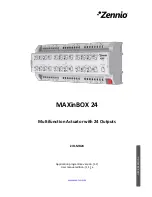
www.ti.com
USB Ports
19
SPRUI97A – May 2017
Submit Documentation Feedback
Copyright © 2017, Texas Instruments Incorporated
AM571x Industrial Development Kit (IDK) Evaluation Module (EVM)
Hardware
7
USB Ports
The AM571x IDK EVM contains three USB ports. Two ports are attached to the USB peripherals USB1
and USB2 on the AM5718 processor. The third port provides both XDS100V2 JTAG emulation and UART
Console over the USB. This port simplifies the development environment for programmers using
computers that support this capability such as Windows
®
-based computers.
7.1
Processor USB Port 1
Processor port USB1 is implemented only as a USB host (master). It supports only the USB2.1 (high
speed and lower) data rates. The connector on the board, J23, is a USB2.1 Standard A-type connector.
The ESD devices implemented on this USB port are the TPD2EUSB30 for the DP and DM lines.
Since processor USB port 1 supports host mode, it has the capability to drive 5.0V power on the VBUS
pin. The TPS2065D load switch is controlled by the USB1_DRVVBUS pin for this purpose.
7.2
Processor USB Port 2
Processor port USB2 is implemented as either USB host (master) or USB device (slave). It supports only
the USB2.1 (high speed and lower) data rates. The connector on the board, J45, is a USB2.1 Micro-AB
connector. The ESD device implemented on this USB port is the TPD4S012.
Since processor USB port 2 supports host mode, it has the capability to drive 5.0V power on the VBUS
pin. The TPS2051 load switch is controlled by the USB2_DRVVBUS pin for this purpose.
The USB2.1 standard defines different ranges of capacitance for the VBUS pin depending on whether it is
host or device. Since this port can do either, the AM571x IDK EVM provides the capability to meet either
requirement. The VBUS pin from the connector contains a 4.7µF capacitor that is appropriate for device
mode operation. When operating in host mode, 2-pin header J50 can be shorted to add 150µF of
additional capacitance to the VBUS pin. The shunt for this header is shown on the schematic as M2. It is
not installed on units when shipped as we expect this port to primarily be used in device mode.
7.3
FTDI USB Port
The FTDI bridge device provides both XDS100V2 JTAG emulation and UART Console over the USB. The
connector on the board, J19, is a USB Micro-AB connector but it only operates in device (slave) mode
with the FTDI bridge device. The ESD device implemented on this USB port to the FTDI bridge is the
TPD2E001. Refer to
Section 4.4
for more details on this functionality.
The FTDI USB device is implemented so that it operates from the VBUS power provided over the USB
cable. This allows the FTDI device to remain fully operational during an AM571x IDK EVM power cycle.
This in turn allows the console port to the PC to remain active to allow logging from the serial port
immediately as the AM5718 device boots. It also provides faster re-connect for the XDS100V2 JTAG
emulator.
















































